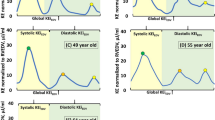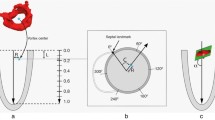Abstract
4D flow cardiac magnetic resonance (CMR) imaging allows visualisation of blood flow in the cardiac chambers and great vessels. Post processing of the flow data allows determination of the residence time distribution (RTD), a novel means of assessing ventricular function, potentially providing additional information beyond ejection fraction. We evaluated the RTD measurement of efficiency of left and right ventricular (LV and RV) blood flow. 16 volunteers and 16 patients with systolic dysfunction (LVEF < 50%) underwent CMR studies including 4D flow. The RTDs were created computationally by seeding virtual ‘particles’ at the inlet plane in customised post-processing software, moving these particles with the measured blood velocity, recording and counting how many exited per unit of time. The efficiency of ventricular flow was determined from the RTDs based on the time constant (RTDc = − 1/B) of the exponential decay. The RTDc was compared to ejection fraction, T1 mapping and global longitudinal strain (GLS). There was a significant difference between groups in LV RTDc (healthy volunteers 1.2 ± 0.13 vs systolic dysfunction 2.2 ± 0.80, p < 0.001, C-statistic = 1.0) and RV RTDc (1.5 ± 0.15 vs 2.0 ± 0.57, p = 0.013, C-statistic = 0.799). The LV RTDc correlated significantly with LVEF (R = − 0.84, P < 0.001) and the RV RTDc had significant correlation with RVEF (R = − 0.402, p = 0.008). The correlation between LV RTDc and LVEF was similar to GLS and LVEF (0.926, p < 0.001). The ventricular residence time correlates with ejection fraction and can distinguish normal from abnormal systolic function. Further assessment of this method of assessment of chamber function is warranted.





Similar content being viewed by others
Data availability
The anonymized datasets analyzed during the current study are available from the corresponding author, on reasonable request.
Abbreviations
- CMR:
-
Cardiac magnetic resonance imaging
- RTD:
-
Residence time distribution
- LV:
-
Left ventricular
- RV:
-
Right ventricular
- EF:
-
Ejection fraction
- GLS:
-
Global longitudinal strain
- 4D:
-
Four dimensional
- DCM:
-
Dilated cardiomyopathy
- ECV:
-
Extracellular volume
References
Eriksson J, Carlhäll C, Dyverfeldt P, Engvall J, Bolger AF, Ebbers T (2010) Semi-automatic quantification of 4D left ventricular blood flow. J Cardiovasc Magn Reson 12:9–10
Bolger A, Heiberg E, Karlsson M et al (2007) Transit of blood flow through the human left ventricle mapped by cardiovascular magnetic resonance. J Cardiovasc Magn Reson 9:741–747
Eriksson J, Bolger AF, Ebbers T, Carlhall CJ (2013) Four-dimensional blood flow-specific markers of LV dysfunction in dilated cardiomyopathy. Eur Heart J Cardiovasc Imaging 14:417–424
Fogler HS (2016) Elements of chemical reaction engineering. Prentice Hall
Miller CA, Naish JH, Bishop P et al. (2013) Comprehensive validation of cardiovascular magnetic resonance techniques for the assessment of myocardial extracellular volume. Circ Cardiovasc Imaging 6:373–383
Kellman P, Wilson JR, Xue H, Ugander M, Arai AE (2012) Extracellular volume fraction mapping in the myocardium, part 1: evaluation of an automated method. J Cardiovasc Magn Reson BioMed Central 14:63
DeLong ER, DeLong DM, Clarke-Pearson DL (1988) Comparing the areas under two or more correlated receiver operating characteristic curves: a nonparametric approach. Biometrics 44:837–845
Curtis JP, Sokol SI, Wang Y et al (2003) The association of left ventricular ejection fraction, mortality, and cause of death in stable outpatients with heart failure. J Am Coll Cardiol 42:736–742
Trichon BH, Felker GM, Shaw LK, Cabell CH, O’Connor CM (2003) Relation of frequency and severity of mitral regurgitation to survival among patients with left ventricular systolic dysfunction and heart failure. Am J Cardiol 91:538–543
Donal E, De Place C, Kervio G et al (2009) Mitral regurgitation in dilated cardiomyopathy: value of both regional left ventricular contractility and dyssynchrony. Eur J Echocardiogr 10:133–138
Thomas L, Hoy M, Byth K, Schiller N (2007) The left atrial function index: a rhythm independent marker of atrial function. Eur J Echocardiogr 2008:356–362
Stanton T, Leano R, Marwick TH (2009) Prediction of All-cause mortality from global longitudinal speckle strain: comparison with ejection fraction and wall motion scoring. Circ Cardiovasc Imaging 2:356–364
Biering-Sørensen T, Mogelvang R, Jensen JS (2015) Prognostic value of cardiac time intervals measured by tissue Doppler imaging M-mode in the general population. Heart BMJ 101:954–960
Iles L, Pfluger H, Phrommintikul A et al (2008) Evaluation of diffuse myocardial fibrosis in heart failure with cardiac magnetic resonance contrast-enhanced T1 mapping. J Am Coll Cardiol 52:1574–1580
Stoll V, Hess AT, Eriksson J et al (2016) The kinetic energies of left ventricular 4D flow components correlate with established markers of prognosis and represent novel imaging biomarkers in both ischaemic and dilated cardiomyopathy. J Cardiovasc Magn Reson 18:O68
Svalbring E, Fredriksson A, Eriksson J et al. (2016) Altered diastolic flow patterns and kinetic energy in subtle left ventricular remodeling and dysfunction detected by 4D flow MRI. PLoS ONE 11:e0161391
Elbaz MSM, Calkoen EE, Westenberg JJM, Lelieveldt BPF, Roest AAW, van der Geest RJ (2014) Vortex flow during early and late left ventricular filling in normal subjects: quantitative characterization using retrospectively-gated 4D flow cardiovascular magnetic resonance and three-dimensional vortex core analysis. J Cardiovasc Magn Reson 16:45
Acknowledgements
We thank the Baker Heart and Diabetes Institute radiology staff for their assistance in this project.
Funding
The study was funded by a research grant from Monash Institute of Medical Engineering (MIME) and by a National Health and Medical Research Council of Australia grant.
Author information
Authors and Affiliations
Contributions
BC: conception, design and analysis and interpretation of data, and drafting of the manuscript; MQ: development of MATLAB code, analysis of data and revision of the manuscript; BP: development of MATLAB code; MT: development of code and revision of manuscript: JH: conception and design and revision of the manuscript; ALG: analysis and interpretation of data, revision of manuscript; MR: development of MATLAB code, analysis of data, revision of manuscript; AJT: conception, design and analysis and interpretation of data, revision of the manuscript and final approval.
Corresponding author
Ethics declarations
Conflict of interest
On behalf of all authors, the corresponding author states that there is no conflict of interest.
Ethical approval
The study was approved by the Alfred Hospital Ethics Committee (Melbourne, Australia) and carried out under their guidelines.
Informed consent
Prior to inclusion in the study written informed consent was obtained from all participants.
Consent for publication
All authors declare their consent for publication.
Electronic supplementary material
Below is the link to the electronic supplementary material.
10554_2018_1407_MOESM1_ESM.avi
Multimedia: Video file of particle traces with seeding plane at the mitral valve over five cardiac cycles in a participant with a left ventricular ejection fraction of 60%. (AVI 43589 KB)
Rights and permissions
About this article
Cite this article
Costello, B.T., Qadri, M., Price, B. et al. The ventricular residence time distribution derived from 4D flow particle tracing: a novel marker of myocardial dysfunction. Int J Cardiovasc Imaging 34, 1927–1935 (2018). https://doi.org/10.1007/s10554-018-1407-0
Received:
Accepted:
Published:
Issue Date:
DOI: https://doi.org/10.1007/s10554-018-1407-0




